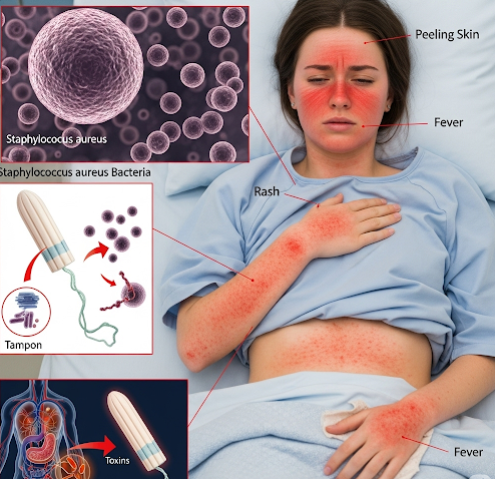Overview
Toxic Shock Syndrome (TSS) is a rare but life-threatening condition caused by bacterial toxins, most commonly produced by Staphylococcus aureus or Streptococcus pyogenes. These toxins trigger a massive immune response, leading to systemic inflammation, organ dysfunction, and potentially death if untreated. In South Korea, advanced medical centers and hospitals provide rapid diagnosis, intensive care, and targeted treatment to manage TSS effectively. Early recognition, prompt medical intervention, and public awareness are critical to improving outcomes for affected individuals.
What is Toxic Shock Syndrome?
TSS is a severe systemic illness caused by toxin-producing bacteria. These toxins act as superantigens, overstimulating the immune system and releasing large amounts of inflammatory cytokines. The condition often progresses rapidly, with symptoms including high fever, hypotension, rash, and multi-organ involvement. TSS can be classified into menstrual and non-menstrual types. Menstrual TSS is historically associated with tampon use, while non-menstrual TSS can result from wounds, surgical sites, burns, or other infections. Korean healthcare providers use laboratory testing and clinical criteria to promptly identify TSS and begin aggressive management.
Symptoms
Symptoms of TSS develop suddenly and can escalate quickly. Common features include:
- Sudden high fever, often above 39°C (102°F)
- Low blood pressure (hypotension), leading to dizziness or fainting
- Rash resembling sunburn, often on palms, soles, or trunk
- Redness of eyes, mouth, or throat
- Nausea, vomiting, or diarrhea
- Muscle aches and severe fatigue
- Confusion, disorientation, or altered mental status
- In severe cases, organ failure affecting kidneys, liver, or lungs
- Peeling of skin on fingers or toes during recovery
In South Korea, emergency departments are trained to recognize early signs of TSS to initiate immediate treatment and prevent complications.
Causes
TSS is primarily caused by bacterial toxins, with major sources including:
- Staphylococcus aureus: Produces toxins such as TSST-1, often associated with tampon use or skin infections
- Streptococcus pyogenes: Produces toxins leading to streptococcal TSS, often from wounds or surgical sites
- Other bacterial infections: Rarely, other bacteria may contribute
- Tampon use or nasal packing: High-absorbency tampons or prolonged use can create an environment for bacterial growth
- Skin injuries or post-surgical wounds: Provide a route for bacterial entry
Korean public health guidelines emphasize hygiene, careful monitoring of wounds, and safe use of menstrual products to reduce TSS risk.
Risk Factors
Several factors increase the risk of developing TSS:
- Use of high-absorbency tampons or prolonged tampon use
- Recent surgery, burns, or skin injuries
- Chronic skin conditions or infections
- Postpartum or post-abortion infections
- Immunocompromised individuals or those with chronic illnesses
- Children and young adults, particularly women of menstruating age
Healthcare providers in Korea educate high-risk populations to recognize early symptoms and seek urgent medical care.
Complications
TSS can lead to serious, life-threatening complications if not treated promptly:
- Shock due to dangerously low blood pressure
- Multi-organ failure, including kidneys, liver, and heart
- Sepsis and systemic infection
- Long-term organ damage, particularly kidney injury
- Death in severe, untreated cases
- Secondary infections or complications from prolonged hospitalization
Rapid diagnosis and intensive care management in South Korean hospitals significantly reduce mortality and long-term complications.
Prevention
Preventive measures for TSS focus on hygiene, early recognition, and minimizing bacterial exposure:
- Safe menstrual practices: Regular tampon changes, using lower absorbency products, and alternating with pads
- Proper wound care: Cleaning and monitoring cuts, burns, or surgical sites
- Prompt medical attention: For infections, fevers, or unusual rashes
- Avoidance of nasal packing for extended periods without medical supervision
- Education and awareness: Recognizing early signs such as sudden fever, rash, or low blood pressure
Public health campaigns in Korea stress personal hygiene and early intervention as key strategies to prevent TSS.
Treatment Options in Korea
Treatment of TSS in South Korea is urgent and multidisciplinary, combining supportive care and targeted therapy:
Diagnosis:
- Clinical assessment based on fever, rash, hypotension, and organ involvement
- Blood tests, including cultures, to identify bacterial pathogens
- Laboratory evaluation of kidney and liver function, electrolytes, and coagulation status
- Imaging studies if deep-seated infections or abscesses are suspected
Medical Treatments:
- Intravenous antibiotics: Broad-spectrum initially, narrowed based on culture results
- Fluid resuscitation: To maintain blood pressure and prevent shock
- Vasopressors: For severe hypotension
- Surgical intervention: Drainage of abscesses or removal of infected tissue if necessary
- Supportive care in ICU: Monitoring and managing organ dysfunction
Supportive Care:
- Pain management and fever control
- Oxygen therapy or mechanical ventilation if respiratory compromise occurs
- Nutritional support and electrolyte management
- Psychological support for patients and families during recovery
South Korean hospitals utilize state-of-the-art intensive care facilities, multidisciplinary teams, and rapid intervention protocols to optimize survival and recovery for TSS patients.













